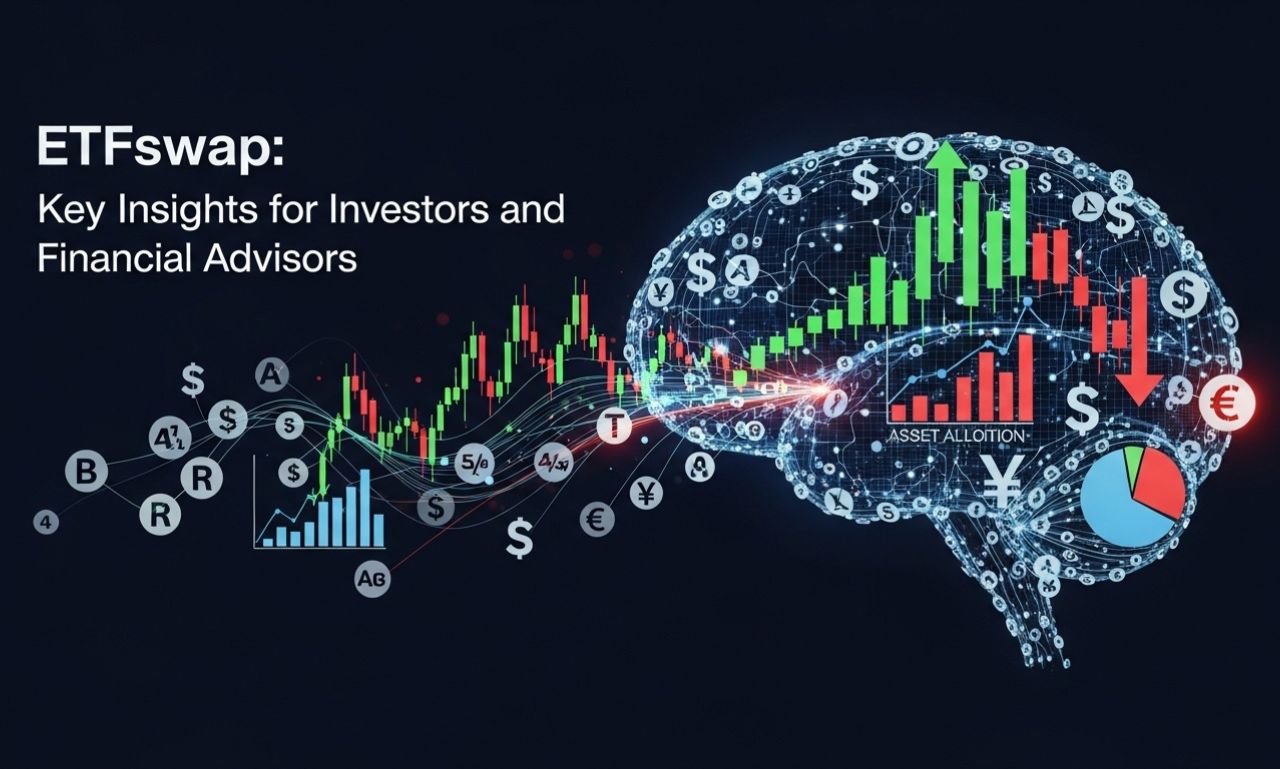In today’s fast-paced financial landscape, savvy investors and advisors alike are always on the lookout for innovative tools to enhance their strategies. Enter Etfswap—a game-changing platform designed specifically for those navigating the world of Exchange-Traded Funds (ETFs). As interest in ETF investing continues to soar, understanding how this tool integrates into investment strategies is crucial. Whether you’re a seasoned investor or just starting out, discovering the nuances of Etfswap can open doors to new opportunities and efficiencies in managing your portfolio. Let’s dive deeper into what makes Etfswap stand out in an ever-evolving market.
What is Etfswap?
Etfswap is an innovative platform designed to simplify the process of trading and managing exchange-traded funds (ETFs). It offers investors a seamless way to swap one ETF for another without incurring significant transaction costs.
This approach not only enhances liquidity but also allows users to adjust their portfolios more efficiently. With Etfswap, you can navigate the complexities of ETF investing with ease.
The platform caters to both individual investors and financial advisors, making it a versatile tool in today’s investment landscape. By streamlining transactions, Etfswap empowers users to make informed decisions quickly.
In essence, it redefines how ETFs are traded and managed, fostering greater accessibility and flexibility within the market. As interest in ETFs continues to grow, solutions like Etfswap play a crucial role in transforming investment strategies for all types of investors.
Understanding ETFs (Exchange-Traded Funds)
Exchange-Traded Funds, commonly known as ETFs, are investment funds that trade on stock exchanges. They resemble individual stocks but contain a collection of assets such as bonds, commodities, or other securities.
One of the defining features of ETFs is their ability to be bought and sold throughout the trading day. This flexibility allows investors to react quickly to market fluctuations.
ETFs provide access to various markets and sectors with relative ease. Investors can diversify their portfolios without having to purchase each underlying asset individually.
The pricing mechanism for ETFs is also intriguing. Their value fluctuates based on supply and demand in real-time, similar to how stocks behave during trading hours.
This dynamic nature positions ETFs as an attractive option for both novice and seasoned investors seeking efficiency and diversification within their investment strategies.
The Rise of ETF Investing
The growth of ETF investing has been nothing short of remarkable. In recent years, these financial instruments have gained immense popularity among both retail and institutional investors.
Their appeal lies in the ease of access they offer. Unlike traditional mutual funds, ETFs trade on exchanges just like stocks. This allows investors to buy or sell shares throughout the trading day at market prices.
Another significant factor driving their rise is cost efficiency. ETFs typically come with lower expense ratios compared to mutual funds, making them a more attractive option for budget-conscious investors.
Additionally, they provide diversification across various asset classes without requiring substantial capital outlay. Investors can gain exposure to entire sectors or regions effortlessly.
As technology advances and investment platforms evolve, ETF adoption continues to soar. More people are recognizing the advantages these funds bring to modern portfolio management.
Benefits of ETFs for Investors
ETFs, or Exchange-Traded Funds, offer a wealth of benefits for investors. One standout feature is their diversification. By investing in a single ETF, you can gain exposure to hundreds of stocks or bonds across various sectors.
Liquidity is another major advantage. ETFs trade on stock exchanges just like individual stocks. This means you can buy and sell throughout the trading day at market prices, providing flexibility that traditional mutual funds lack.
Cost-effectiveness also makes ETFs appealing. They typically have lower expense ratios compared to mutual funds. This allows investors to keep more of their profits over time.
Furthermore, transparency is key with ETFs. Investors can see exactly what assets are held within the fund on a daily basis, fostering confidence and informed decision-making.
Tax efficiency plays an important role in ETF advantages due to their unique structure, which often results in fewer capital gains distributions than mutual funds.
How ETFs Differ from Mutual Funds
ETFs and mutual funds serve similar purposes but operate in distinct ways.
One major difference is how they trade. ETFs are bought and sold on an exchange, much like stocks. This allows investors to react quickly to market changes throughout the day.
Mutual funds, however, are only traded at the end of each trading day. Investors place orders during the day, but transactions are executed based on that day’s closing price.
Cost structures also differ significantly. ETFs often have lower expense ratios than mutual funds. They may come with trading commissions, yet these costs can be offset by their tax efficiency.
Additionally, transparency plays a role. Most ETFs disclose their holdings daily, giving investors real-time insight into what they’re investing in. Mutual funds typically report their holdings quarterly or semi-annually, making them less transparent for active investors seeking immediate information.
Challenges and Risks of ETF Investing
Investing in ETFs can be appealing, but it comes with its own set of challenges. One major concern is market volatility. Prices can fluctuate significantly, impacting investor returns.
Liquidity is another factor to consider. While many ETFs are traded daily, some may have lower trading volumes, leading to wider bid-ask spreads and potential difficulties when buying or selling shares.
Tracking errors also pose a risk. An ETF aims to mirror the performance of an index but might not always do so perfectly due to management fees and other expenses.
Additionally, investors should be wary of over-diversification. Holding too many different ETFs might dilute gains and complicate portfolio management more than necessary.
Regulatory changes can affect the landscape for ETFs. Investors need to stay informed about new rules that could impact their investments or alter how funds operate within the market.
The Role of Financial Advisors in ETF Investing
Financial advisors play a crucial role in the world of ETF investing. Their expertise helps investors navigate the complexities of various funds available on the market. With thousands of ETFs to choose from, a seasoned advisor can tailor recommendations based on individual goals and risk tolerance.
These professionals also provide insights into market trends and shifts that may affect investment choices. They help clients understand how specific ETFs align with their broader financial strategies.
Moreover, advisors assist in portfolio construction, ensuring diversification across sectors or asset classes. This balance is essential for managing risks while aiming for optimal returns.
Additionally, they educate investors about fees and tax implications associated with ETF transactions. This transparency fosters informed decision-making and encourages long-term investment success.
In an ever-evolving financial landscape, having a skilled advisor by your side can make all the difference in maximizing the benefits of ETF investing.
Introducing Etfswap: A New Solution for Investors and Financial Advisors
Etfswap is reshaping the landscape of investment strategies for both individual investors and financial advisors. This innovative platform simplifies the process of trading ETFs, making it accessible to a broader audience.
With Etfswap, users can seamlessly exchange one ETF for another without incurring hefty transaction fees. This feature encourages strategic reallocations based on market conditions or personal investment goals.
The intuitive interface allows users to monitor their portfolios in real time. Investors can make informed decisions with up-to-date information at their fingertips.
Financial advisors also benefit from Etfswap’s streamlined processes. The platform enhances client interactions by providing tools that facilitate efficient portfolio management.
By prioritizing transparency and ease of use, Etfswap paves the way for smarter investing. It empowers users to take control of their financial futures while minimizing complexities traditionally associated with ETF transactions.
Conclusion
The world of ETFs is growing rapidly, and with it comes the need for innovative solutions like Etfswap. This platform offers a seamless way for investors and financial advisors to navigate the complexities of ETF investing. As more individuals look toward ETFs as their preferred investment vehicle, understanding their mechanics becomes essential.
Investors can take advantage of lower costs, diversified portfolios, and ease of trading that ETFs offer. Financial advisors play a crucial role in guiding clients through these opportunities while managing potential risks associated with market volatility.
Etfswap stands out by providing tools designed to simplify these transactions and enhance decision-making processes for both investors and advisors alike. By embracing this technology, all parties involved can optimize their strategies in an ever-evolving marketplace.
As you contemplate your next investment move or seek guidance from a financial advisor, consider how Etfswap might fit into your strategy. The landscape is changing fast; staying informed will help ensure you make the best decisions moving forward.

